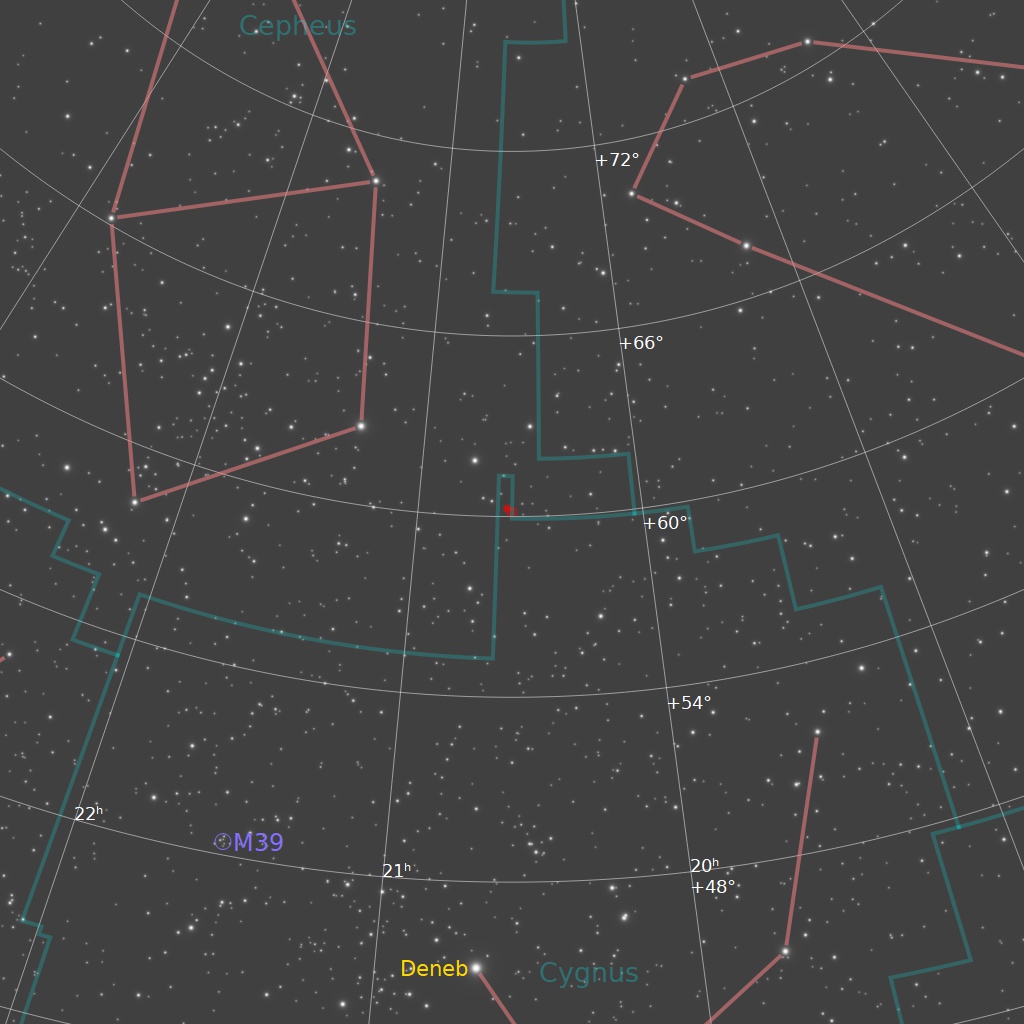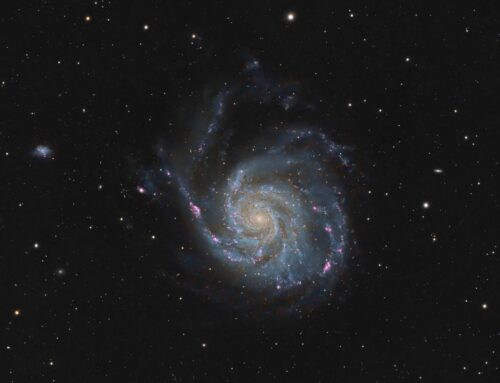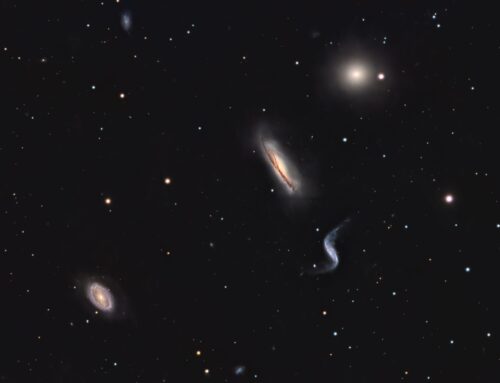NGC 6946, The Fireworks Galaxy
 Click image for full size version
Click image for full size version
August 28, 2023
NGC 6946 is also known as the Fireworks Galaxy, and it’s easy to see why. The reddish highlights are star-forming regions, similar to the Orion Nebula in our own Milky Way galaxy. We see it face on, so it’s possible to see lots of dark dusty lanes between the blue arms full of stars. In addition to looking like a fireworks display, this galaxy has acted like one: there have been 10 supernova explosions observed in it since 1917, most recently in 2017. It would be even brighter if it wasn’t so heavily obscured by our own galaxy’s dust lane. There’s likely a black hole gobbling up stars concentrated in the bright core of the galaxy. At 22 million light years away, it’s just a stone’s throw as far as galaxies go.
I’ve imaged this galaxy several times before, always at much lower resolution. It lies not far from open cluster 6939, and they make a nice photo together. But I have to say that I am definitely having some fun getting close-ups with the new (to me) Celestron 14″ EDGE HD!
Tekkies:
Acquisition, focusing, and control of Paramount MX mount with N.I.N.A., TheSkyX and PHD2. Primalucelab low-profile 2″ Essato focuser and ARCO rotator. Equipment control with PrimaLuce Labs Eagle 3 (2021) and 4 (2023) Pro computer. All pre-processing and processing in PixInsight. Acquired from my SkyShed in Guelph. Average transparency and seeing. Data acquired August 20-28, 2023 in a moderately moonlit sky.
Celestron 14″ EDGE HD telescope at f/11 (3,912 mm focal length) and QHY600M camera binned 2×2 with Optolong filters.
27x5m Red = 2hr15m
19x5m Green = 1hr35m
14x5m Blue = 1hr10m
20x5m Ha = 1hr40m
46x5m Lum = 3hr50m
Total: 10hr50m
Preprocessing: The WeightedBatchPreProcessing script was used to perform calibration, cosmetic correction, weighting, registration, local normalization and integration of all frames.
Colour master: A colour master was made from the Red, Green and Blue masters using ChannelCombination in RGB mode.
Gradient Removal: DynamicBackgroundExtraction was applied to the RGB, Ha and Lum masters.
Colour Calibration: ColorCalibration was used to calibrate the RGB master.
Deconvolution: BlurXterminator was used on the Ha, Lum and RGB masters with Automatic psf , and star sharpening set to 0.10 with “Correct First” selected.
Linear Noise Reduction: NoiseXterminator was applied to each master image with settings Amount=0.9 and Detail=0.15
Stretching: HistogramTransformation was applied to the RGB, Ha and Lum image to make pleasing images. Approximate background level after stretch was 0.10 for RGB and Lum, and 0.08 for Ha and O3.
Nonlinear Processing
Luminance addition: LRGBCombination was applied to replace the lightness of the Colour image with the Luminance master.
Star Removal: StarXterminator was used to remove the stars from the resulting LRGB image, with Unscreen selected. Stars were removed from the Ha master and discarded.
Addition of Ha: PixelMath was used to blend Ha into the LRGB image using the following expression with parameter values a=1.2 and b=0.07.
Red: max($T[0], a*Ha)
Green: $T[1]
Blue: iif($T[0]<a*Ha, $T[2] + b * Ha, $T[2])
Nonlinear Noise Reduction: NoiseXterminator was used to reduce noise in the background areas of the image with settings Amount=0.9 and Detail=0.2
Histogram Stretch: HistogramTransformation was used to reset the black point and increase brightness in the galaxy slightly.
Contrast Enhancement: LocalHistogramEqualization was applied three times. A Contrast Limit of 1.5 and 1 iteration was used for each LHE application (scale 30, strength 0.35; scale 80, strength 0.25; scale 150, strength 0.18).
Sharpening: A mask was used to select brighter regions of nebulosity for sharpening with MultiscaleMedianTransform (Layers 1 – 5 with strengths of 0.01, 0.02, 0.02, 0.01, and 0.01, respectively).
Star Restoration: PixelMath expression combine(starless, stars, op_screen()) was used to combine the starless and stars-only images created with StarXterminator.
Final Steps: Background, galaxy and star brightness, contrast and saturation were adjusted in several iterations using CurvesTransformation with masks as required. ICCProfileTransformation (sRGB IEC61966-2.1; Relative Colorimetric with black point compensation) was applied prior to saving as a jpg. The finder chart was made using the FindingChart process.







Fantastic
Beautiful!!
Very nice, love the detail you get from narrowband.
Great detail and color, especially the core
Gorgeous image, like always!